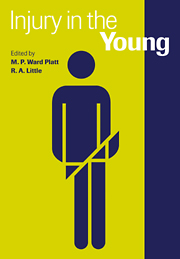Book contents
- Frontmatter
- Contents
- List of contributors
- Editors' Preface
- 1 The epidemiology of trauma involving children
- 2 Emergency room requirements for children
- 3 Child deaths in Accident and Emergency
- 4 Immediate life support
- 5 Evaluation of injury in children
- 6 Injuries of the developing brain
- 7 Wound healing in children
- 8 The lung after injury in children
- 9 Metabolic and endocrine stress responses to surgery
- 10 Head injury in children
- 11 Near drowning
- 12 The acute response to burn injury in children
- 13 Nutritional support of the severely burned child
- 14 Recovery, rehabilitation and the neuropsychological sequelae of head injury
- 15 Children's rights and child protection
- Index
9 - Metabolic and endocrine stress responses to surgery
Published online by Cambridge University Press: 18 September 2009
- Frontmatter
- Contents
- List of contributors
- Editors' Preface
- 1 The epidemiology of trauma involving children
- 2 Emergency room requirements for children
- 3 Child deaths in Accident and Emergency
- 4 Immediate life support
- 5 Evaluation of injury in children
- 6 Injuries of the developing brain
- 7 Wound healing in children
- 8 The lung after injury in children
- 9 Metabolic and endocrine stress responses to surgery
- 10 Head injury in children
- 11 Near drowning
- 12 The acute response to burn injury in children
- 13 Nutritional support of the severely burned child
- 14 Recovery, rehabilitation and the neuropsychological sequelae of head injury
- 15 Children's rights and child protection
- Index
Summary
Introduction
The neuroendocrine stress response to surgical injury is well understood in adult humans. Although there remains a serious lack of published data on the stress response to accidental injury in children, the response to surgical injury is now much better understood. This chapter focuses on current knowledge in relation to the stress response to surgery in infants and children.
Most surgery in children and neonates is essentially safe. For ‘general’ surgery there is a low direct mortality and the morbidity is mostly that of the underlying disease process for which the surgery is being undertaken. In some areas of surgery, for instance cardiac surgery, opposing trends are evident. While some major procedures are now more common, because of technical advances (e.g. switch operations for transposition of the great arteries), the development of transluminal techniques for closure of patent arterial duct will reduce the exposure of children to open surgery for this condition. Laparoscopic techniques for general surgery will probably become more frequent in children as experience develops.
The importance of developing a scientific understanding of the processes involved in the response to elective surgery is threefold:
it is a constant challenge to improve outcome among those children undergoing emergency surgery, including that for trauma
surgery for conditions such as complex congenital heart disease carries much greater hazards than ‘general’ surgery: this challenges us to improve outcome further
[…]
- Type
- Chapter
- Information
- Injury in the Young , pp. 128 - 150Publisher: Cambridge University PressPrint publication year: 1998



